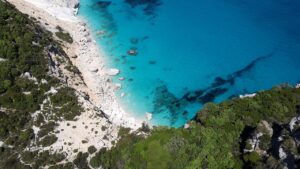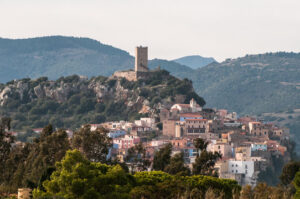Table of Contents
A Comprehensive Guide to Fordongianus, Sardinia: Exploring the Hidden Gem
Introduction
Nestled in the heart of Sardinia, in the province of Oristano, lies the charming town of Fordongianus. Often overlooked in favor of the coastal destinations, Fordongianus is a true hidden gem waiting to be discovered. This small town boasts a rich history, ancient ruins, beautiful churches, and even thermal baths, making it an ideal destination to explore, even in the winter months. In this comprehensive guide, we will delve into the fascinating history of Fordongianus and explore its main attractions, ensuring you have all the information you need to make the most of your visit.
The History of Fordongianus
Fordongianus has a long and storied history that dates back to the Roman times. Originally known as Forum Traiani, the town was founded during the late Republic period by the Romans. Even in those ancient times, Fordongianus was renowned for its thermal baths, which utilized a natural source of healing water known as Aquae Hypsitanae. Under the rule of Emperor Trajan, Forum Traiani became a hub of trade and interaction between the communities of the Gulf of Oristano and the inland regions of the island.
During the Middle Ages, Fordongianus became part of the Giudicato of Arborea before falling under Aragonese rule during the Spanish conquest of Sardinia. The town then became a feudal estate until the abolition of the feudal system in 1839.
What to See in Fordongianus
Despite its small size, Fordongianus offers a wealth of attractions for visitors to explore. From archaeological sites to historical buildings, there is something for everyone. Let’s take a closer look at the must-see sights in Fordongianus.
Terme Romane (Roman Baths)

The Romans had a deep appreciation for thermal baths and believed in the healing properties of thermal water. This led to the founding of Fordongianus and the construction of the Terme Romane in the 1st century A.D. The archaeological area of the Terme Romane is divided into two sections: one with a rectangular pool and another with a changing room. The floors are adorned with intricate mosaics, while the ceilings are made of blue glass paste. The baths drew water from the natural springs through a network of wells and cisterns. The presence of statues of Bes, an Egyptian deity associated with wealth and fortune, along with depictions of nymphs on the edges of the pools, attests to the importance of the baths since Roman times.
Anfiteatro Romano (Roman Amphitheater)
In addition to the Roman baths, Fordongianus is home to the remains of a Roman amphitheater. Located just outside the town center, the amphitheater has not yet been fully excavated but is still an impressive sight. It follows the architectural techniques of the Romans, featuring spacious arenas for gladiator fights and various spectacles, often involving wild animals. Excavations in 1996 and 2008 revealed that the amphitheater was expanded to accommodate a growing population. At its peak, it could hold up to 3,000 spectators, making it one of the largest Roman amphitheaters in Sardinia, surpassed only by the one in Cagliari.
Casa Aragonese (Aragonese House)
Dating back to the 15th and 16th centuries, Casa Aragonese is a unique architectural blend of the central Sardinian style and the Aragonese architecture found in the Aragon region of Spain. The exterior of the house features a distinctive front porch facing the courtyard, constructed with red trachyte and supported by columns resting on a long stone seat. Inside, the Aragonese house is divided into two units, comprising a total of thirteen rooms. The dining-living room boasts a large fireplace, while the bedroom and kitchen offer a glimpse into the daily life of the past. The rooms are adorned with intricately carved cupboards and chairs depicting religious emblems, animals, plants, and geometric patterns. The rear part of the house features a garden with a vegetable patch, a storage area, and a stable.
Chiesa di San Lussorio (Church of San Lussorio)
The Chiesa di San Lussorio is an ancient church dating back to the 7th century. Situated on a hill, surrounded by muristenes (dwellings built to accommodate pilgrims), this church is a testament to the rich religious history of Fordongianus. Constructed using trachyte stone blocks, the church has undergone several renovations over the years, including one in the 13th century following a structural collapse. Another intervention in the 15th century resulted in the addition of a portal in Catalan-Gothic style. The Chiesa di San Lussorio is dedicated to the martyr Lussorio, who was executed for converting to Christianity. It is located approximately two kilometers from Fordongianus and offers a tranquil retreat for visitors seeking spiritual solace.
Bagni Termali (Thermal Baths)
Located near the Antiche Terme Romane (Ancient Roman Baths) of Fordongianus, the modern thermal baths complex was built in the 19th century on the banks of the Tirso river. These thermal baths are renowned for their therapeutic properties, particularly in the fields of rheumatology, orthopedics, and dermatology. The baths maintain a temperature range of 41 to 43°C (106 to 109°F) and are built directly on the source of the river, ensuring a completely natural experience. Visitors can enjoy the thermal baths for a relaxing half-hour session, although it is advisable not to stay in the water for more than ten minutes due to the high temperature. The facility also offers cold shower stalls and toilets for convenience. It is essential to book your visit in advance. For more information and reservations, visit the official website.
Other Interesting Places to Explore
In addition to the main attractions mentioned above, Fordongianus offers a few other noteworthy sites worth visiting. These include:
- Chiesa di Santi Pietro e Archelao: This church showcases various architectural styles, reflecting its different phases of construction during the paleo-Christian era, the Middle Ages, and the period of the Judicates in Sardinia. The influence of the Aragonese is also evident in this church.
- Ancient Roman Road and Roman Bridge: Near the thermal baths, you can find remnants of an ancient Roman road and a Roman bridge. These historical features provide insights into the region’s past and make for fascinating explorations.
- Nuraghi and Archaeological Sites: For those seeking a deeper dive into Sardinia’s ancient history, the ruins of Casteddu Ecciu, the monolith of Crastu Ladu, and the underground tomb of Sa Domu e Sa Senora offer glimpses into the island’s rich archaeological heritage.
How to Get to Fordongianus
From Oristano
Oristano serves as an excellent base for exploring the central part of Sardinia and the picturesque Sinis Peninsula. If you’re traveling by car from Oristano, take the SS388 road towards Tirso and Mandrolisai. Follow this road until you reach a roundabout, then continue straight on the SP35. At the second roundabout, turn left onto the SP33, which will lead you to Fordongianus. The journey takes approximately 30 minutes. Alternatively, you can opt for the convenience of public transportation. Take the line 537 Tonara – Sorgono – Samugheo – Oristano bus, which will take you to Fordongianus in around 45 minutes.
While in Oristano, don’t miss the opportunity to explore the stunning Sinis Peninsula.
From Cagliari
If you’re based in Cagliari and have access to a car, Fordongianus is also easily accessible for day trips. Simply take the SS131 road northbound towards Marrubiu and then follow the SP68 and SP33 roads to reach your destination.
Where to Eat in Fordongianus
While Fordongianus may have limited dining options, the available establishments offer delightful culinary experiences. One highly recommended restaurant-pizzeria is Il Naviglio. Don’t be deceived by its rustic and unassuming appearance; the friendly staff and excellent food make it a hidden gem. Be sure to try their specialty, the local lorighittas pasta, paired with traditional pork meat sauce or seasonal artichokes. For more dining options, consider Sa Montigu and the tavern Sa Lussorio, known for their refined dishes.
Conclusion
Fordongianus may be small in size, but it offers a treasure trove of history, natural beauty, and cultural experiences. From the ancient Roman baths and amphitheater to the charming Casa Aragonese and the serene Chiesa di San Lussorio, there is much to discover and appreciate in this hidden gem of Sardinia. Whether you’re seeking relaxation at the thermal baths or a journey into the past through archaeological sites, Fordongianus promises a unique and unforgettable experience. So, pack your bags, immerse yourself in the rich history, and explore the wonders of Fordongianus, the heart of Sardinia.
Additional Information:
- Climate: Fordongianus experiences a Mediterranean climate, characterized by mild winters and hot summers. The best time to visit is during the spring and autumn months when the weather is pleasant and the tourist crowds are smaller.
- Accommodation: While Fordongianus may not have a wide range of accommodation options, there are a few cozy bed and breakfasts and guesthouses available for visitors. Consider booking your stay in advance to secure your preferred choice.
- Local Events: Fordongianus hosts various cultural events and festivals throughout the year, providing opportunities to immerse yourself in the local traditions and celebrations. Keep an eye on the town’s event calendar to make the most of your visit.
- Outdoor Activities: The surrounding countryside offers excellent opportunities for outdoor activities such as hiking, cycling, and horseback riding. Take advantage of the beautiful landscapes and enjoy the fresh air during your stay in Fordongianus.
- Local Cuisine: Sardinian cuisine is known for its unique flavors and traditional dishes. Don’t miss the chance to sample local delicacies such as culurgiones (stuffed pasta), porceddu (roast suckling pig), and seadas (honey and cheese pastries). Pair your meal with a glass of Cannonau, a renowned Sardinian red wine.
Please note that the information provided in this guide is subject to change. It is advisable to check the official websites and local sources for the latest updates on attractions, opening hours, and travel restrictions.





